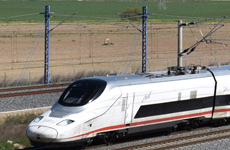
Categories
Publications
High speed as a need to increase the share of long-distance rail traffic
27/1/2017

In 1991 rail traffic in the 31 main Spanish long-distance routes accounted for 4.04 million passengers. If the speed or other characteristics of the offer had not changed since then, in 2015 traffic in these routes would have been reduced by 31 percent to 2.46 million passengers. However, in this period high-speed services were implemented in 13 of these routes while services that partially use high speed were offered in other 15, which has allowed the number of passengers to multiply by 4.6, reaching 18.74 million.
The analysis in this article confirms the observation that conventional long-distance passenger traffic (this being defined as the one that is not developed in high speeds) has been undergoing a continuous loss of market share since the last two decades of the 20th century. In the article we study the reasons for this decline, and the analysis allows us to answer the question about what would have happened with long-distance traffic in Spain if the high-speed network had not been implemented.
Clearly, the decrease in traffic in conventional trains is partly a consequence of the transfer of passengers to high-speed trains, but it is also a result of the improved offer of the car, bus and plane, which have gone from being almost nonexistent 50 years ago to now having an important market share.
Where there is not high speed and the offer of other modes of transport is stabilised, it can be seen how conventional long-distance railway is steadily losing market share. In this article we size up this phenomenon and confirm the hypothesis that, when the offer is the same, the railway only manages to keep and increase its market share if it is high-speed transport, indeed.
It is concluded that this fact is a consequence of the enhanced value of the time of the passengers as the income gradually increases: greater values of the time, as a result of an increased income, make consumers choose the fastest modes of transport and reject the slow ones. The decline of the conventional railway is therefore a consequence of the increase in the income. High speed is essential to keep railway passengers in a situation of higher incomes and thus prevent them from choosing the plane or the private car, with the consequent rise in social costs.
Download paper »



